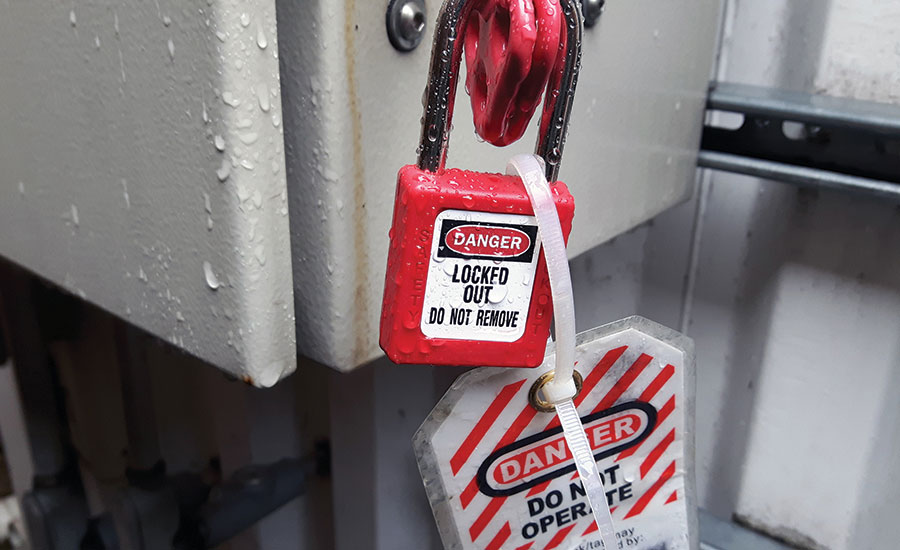
The eternal battle is production versus safety, and at the very center of this is lockout, or better – avoiding lockout. The complaint, by both production and maintenance is that locking out equipment takes too long, or if they lockout, getting the machine back on line could be difficult. They will also argue that the machines have interlock controls that provide effective levels of protection and allow workers to efficiently (and safely) complete their work. The truth: maybe, maybe not.
An interlock is a device that will prevent one element from changing (moving), due to a state in another element. Interlocks in the work setting include electromagnetic switches, RFID proximity switches, light curtains, trap key interlock’s, etc. Interlocks open control circuits but do not isolate equipment from hazardous energy.
A good example to understand interlock is to examine your home washing machine. Washing machines have limit switches (newer models have both limit switches and lid locks) that would not allow the washing machine to run if the lid was in the open position. Raise your hand if as a child growing up you used a pen or a pencil (maybe your finger) to push that limit switch and watch the washing machine go around (author hand in the air). The limit switch (interlock safety device) keeps the machine from moving, but does it isolate it from the energy source? The limit switch does not unplug the electrical cord and turn the cold and hot water valves to the off position. And under the right circumstances (accidentally pushing down on the limit switch with your hand), the interlock can fail in its purpose and activate the machine
Interlocks have been used for decades and are one of the most misunderstood and improperly used safety devices installed on equipment. Their intended use, reliability and integrity from a safety perspective has evolved, where now there are Category 1, 2, 3 and 4 systems. These safety devices were to prevent accidents. They do not provide the equivalent level of protection that lockout provides, which is the OSHA standard. In our example of the washing machine, in terms of current OSHA language, as a child I was bypassing a guard and defeating a safety device. Technically, these are now considered Category 1 Interlock Controls. Similar devices are used every day under the guise of providing effective protection against the expected (or unexpected) start up or release of hazardous energy. Sadly, workers are injured and killed every year due to the failure or misuse of these perceived safety devices.
Your company has Machine “X”, which is currently guarded by Plexiglas around all working parts, with interlocked access doors for workers to access. Operators are charged daily with clearing jams during their shift, which requires the worker to open an interlocked access door. This will stop the machine from running and allow the worker to clear the jam. When completed, the worker closes the door and the machine returns to normal operation.
This scenario plays out every day in companies across the United States and yet, this is in violation of the OSHA standard if the accidental energization of the machine would create a hazard for the worker. Machine “X” is still energized, and we are asking the worker to bypass a guard (they reach through the plane of the Plexiglas), place part of their body in the danger zone or at the point of operation. In this case, lockout should be applied because of the nature of the task and the measures of control in place. These types of interlocks are installed to protect workers in case they were suddenly exposed (door is opened) to an area where body parts should be placed. Over time, these interlocks have been integrated (wrongly) into the daily routines and tasks of production and maintenance where sentiment is that this is “safe” and “compliant.” Neither is true.
These types of task are often repeated several times per shift, to several times per hour. If the worker was to lockout the machine each time, they would spend a large amount of their work day locking the machine out and then returning to service. OSHA leaves it to the employer to determine (and document) what is acceptable in terms of protection when it comes to Alternative Measures of Control. The ANSI Z244.1 standard has recently provided in its 2017 update some guidance on how to determine if the Interlock Control Devices provide equivalent level of protection.
Much has advanced in the technology, reliability and integrity of Interlock systems over the past two decades. The industry has seen the development and deployment of Category 3 and Category 4 Interlock Control Devices. These systems have been proven to increase productivity (uptime) and decrease lockout (downtime), but they do come with a requirement of significant investment in time and resource to install, implement and maintain, and still do not meet OSHA requirements. From the scenario on Machine X, it would be a wise investment to install an interlock system to save a few minutes, several times an hour — which then does increase your production uptime AND protect your workers from hazardous energy.
Too often we find ourselves in conversations with customers who are looking for solutions to avoid lockout as a means to increase production uptime. The majority of the industry has equipment that requires three or fewer locks/devices to achieve a zero-energy state. There is a good argument to use Interlock Control Devices in a particular industry, with particular equipment and involving particular tasks. Invest and protect wisely for true gains in uptime and worker safety.
Read more articles here.
We are here to help you.